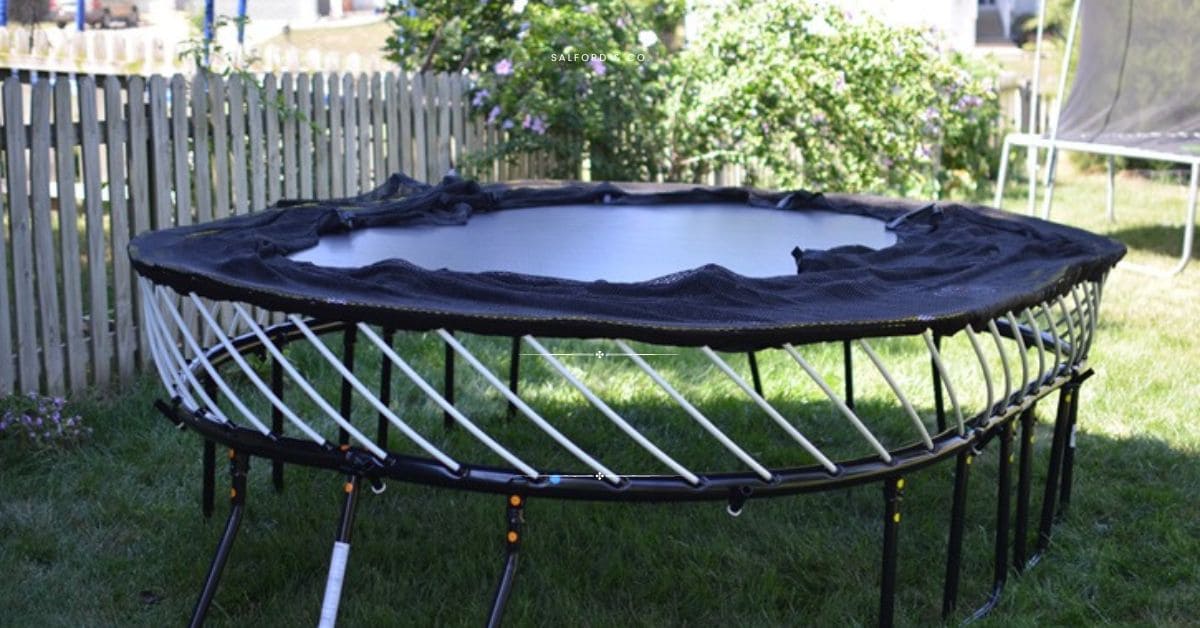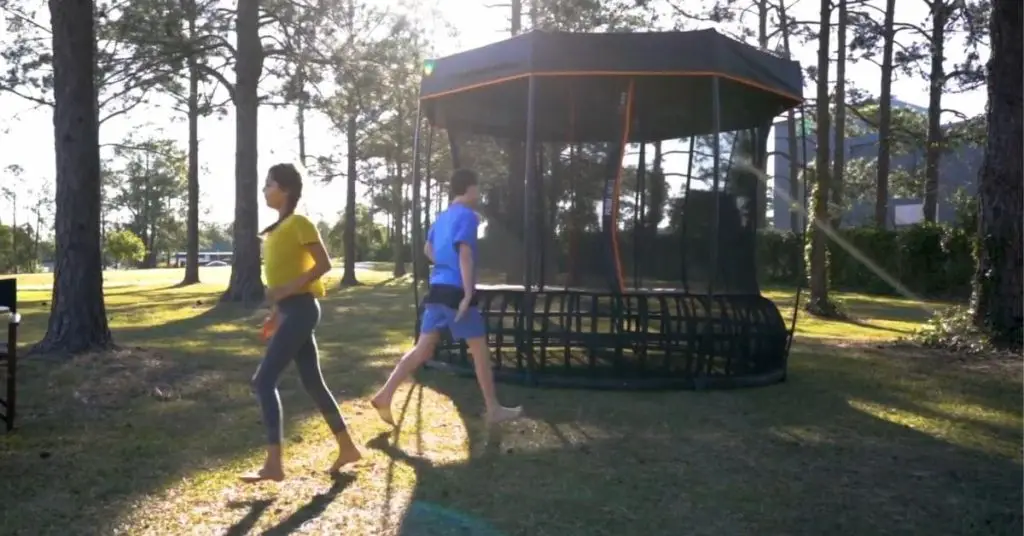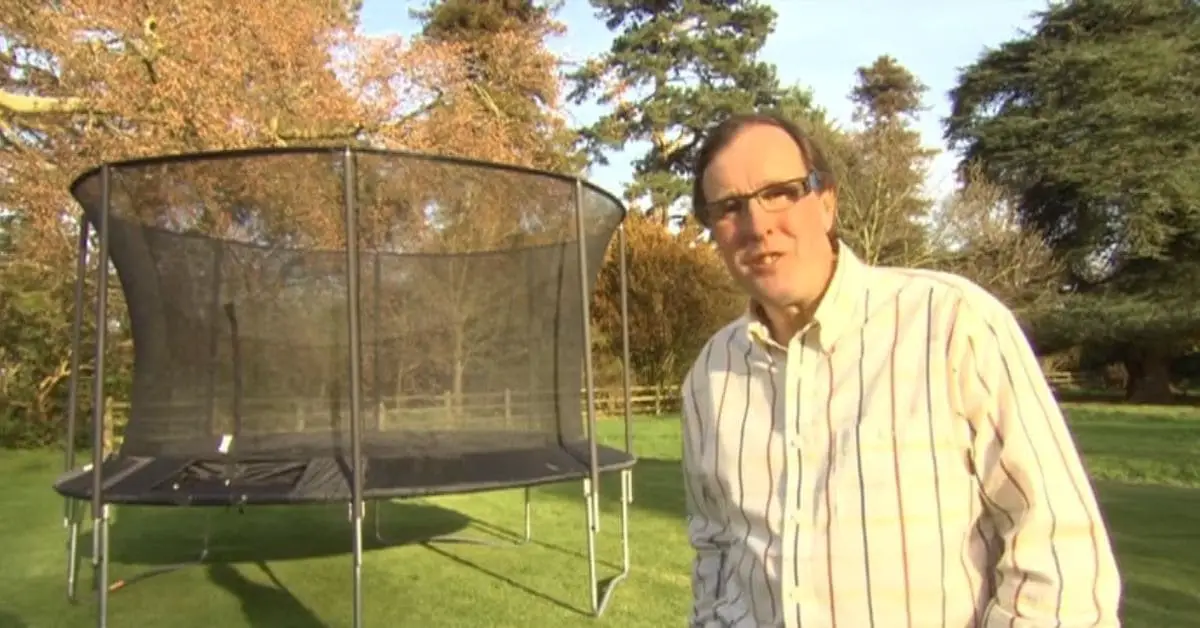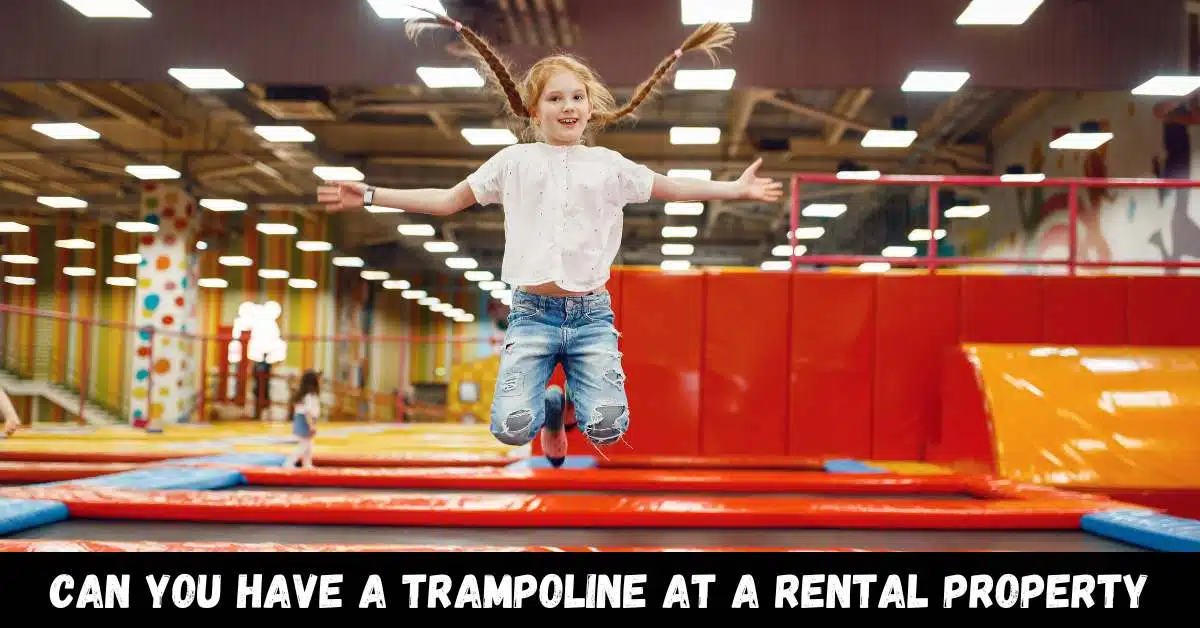Can you have a Trampoline at a Rental Property? Well, that depends on my rental agreement with the people or company I rent the property from.
I need to understand that trampolines are often considered an “attractive nuisance” and are subject to Attractive Nuisance Laws, which can vary by state.
Now, let’s delve deeper into why landlords might have reservations about having a potentially risky piece of recreational equipment on their property.
It’s not always about being mean-spirited or abusing their authority; it’s primarily about safeguarding themselves from potential lawsuits.
Trampoline-related injuries can lead to significant financial liabilities, and landlords want to minimize that risk.
Therefore, it’s crucial for me to carefully examine my rental agreement and perhaps consult local regulations to ascertain whether having a trampoline is allowed.
Establishing open lines of communication with my landlord or property management is paramount in understanding their concerns and addressing them effectively.
Ultimately, I can work towards finding a mutually agreeable solution by prioritizing safety and demonstrating consideration for the property owner’s worries.
Can you have a Trampoline at a Rental Property: Having a trampoline at a rental property depends on the rental agreement and local regulations. Understanding attractive nuisance laws and open communication with the landlord are key factors to consider.
Can you have a Trampoline at a Rental Property?

Most landlords do not permit trampolines at their rental properties; if they allow them, they usually impose strict conditions.
This is because trampolines have a high risk of causing injuries, and even if legal waivers are signed, landlords can still be held liable for any accidents that happen on their property. Additionally, having a trampoline can potentially invalidate home insurance policies.
Trampolines as an Attractive Nuisance:
Trampolines pose a significant risk and can create legal issues for landlords. It is highly unlikely that a landlord will permit a tenant to have a trampoline on their property.
Insurance companies classify trampolines as an “attractive nuisance.” Even if the trampoline is on private property, it can attract children who may use it without the tenant’s permission.
Suppose a child has an accident on the trampoline. In that case, even if they were trespassing without permission, the landlord is more likely to face legal challenges than the tenant who installed the trampoline. Landowners are financially responsible for injuries that occur on their property.
Ultimately, landlords are responsible for ensuring the safety of their tenants and guests. They must maintain a safe property by addressing issues like electrical safety, loose paving slabs, and damaged stairs.
Most landlords consider allowing a trampoline as a “dangerous addition” due to the potential risks involved. Even if a landlord has a good relationship with the tenant, they will still worry about their liability if someone gets injured while using the trampoline.
Trampolines and their Impact on Insurance Policies:
Another reason why landlords may not allow trampolines at rental properties is that it can affect the home insurance policy. Trampolines have a high level of liability, and insurance companies understand that having a trampoline on the property increases the chances of potential claims.
If a trampoline is allowed, the home insurance policy will likely be affected, significantly increasing premiums. In some cases, the presence of a trampoline may even void the insurance policy altogether.
To mitigate these risks, if a trampoline is permitted, the tenant needs to have a renter’s insurance policy that specifically covers the trampoline.
This additional coverage, known as a rider, helps protect against potential liabilities and ensures proper insurance protection for both the tenant and the landlord.
Trampoline Injuries: The Stats:
Trampolines may be a lot of fun, but when we look at the statistics, they can be quite dangerous.
According to the U.S. Consumer Product Safety Commission, over 300,000 trampoline-related injuries required medical treatment in 2018. Shockingly, more than 100,000 of these injuries were serious enough to warrant a visit to the emergency room.
Fractures make up nearly one-third of all trampoline injuries from ER visits.
Trampolines are considered so risky that the American Academy of Pediatrics advises against their use at home, in gym classes, or on playgrounds. They recommend that trampolines be only used in supervised training programs for sports like gymnastics or diving.
Additionally, they stress that only one person should be allowed on a trampoline at a time.
Understanding Waivers of Liability for Trampolines:
In some cases, landlords may permit a trampoline on their property if the tenant signs a waiver of liability or if there is a specific addendum in the lease agreement.
These legal documents, usually prepared by attorneys, outline the risks of trampolines and release the landlord from any responsibility for injuries or damages. The tenant agrees to assume full responsibility for any risks involved.
However, it’s important to note that even with a signed waiver, a landlord can still be held accountable for injuries that occur on the trampoline.
In essence, these waivers provide some level of defense in the event of a lawsuit, but they do not guarantee that the landlord will be completely exempt from liability.
A trampoline on the property remains a risk for the landlord, even with a signed waiver.
Trampoline in an Apartment: Is It Allowed?

Having a trampoline in an apartment can be possible, but it depends on your lease agreement and the rules set by your apartment complex.
Before getting a trampoline, consider where you will store it when not in use.
If your lease agreement doesn’t explicitly say “no” to trampolines, you might be able to have one with your landlord’s permission.
Make sure to show them where you plan to keep it and assure them that it won’t disturb your neighbors.
Your landlord may ask you to get liability insurance before approving the trampoline. Even if trampolines are allowed in your complex, there may still be restrictions. For instance, they might only be allowed in certain areas or at specific times.
To be safe, check with your apartment’s leasing office to understand the rules and regulations regarding trampolines before making any decisions.
Protecting Yourself from Trampoline Lawsuits
No one wants to experience an injury while using a trampoline, but accidents can occur. You might wonder if you have any legal options if you find yourself injured.
The possibility exists, but it depends on the specific circumstances and who is responsible for the accident. Here’s what you should know about trampoline lawsuits.
If the trampoline itself is defective and the manufacturer is to blame, you might have a product liability claim against them. To succeed in such a claim, you must prove that the trampoline’s defect directly caused your injury.
For instance, if the trampoline’s frame was poorly constructed and collapsed while you were using it, resulting in an injury, you might have a case against the manufacturer.
On the other hand, if the trampoline owner is responsible for the accident, you could have a premises liability claim against them. This would be applicable if, for example, they knew about a hole in the trampoline mat but didn’t address it or provide a warning, leading to someone falling through and getting injured.
To win such a claim, you would need to demonstrate that the owner was negligent in maintaining a safe environment for users of the trampoline.
It’s important to note that the viability of a lawsuit will depend on the specific details and evidence related to your situation. Consulting with a legal professional experienced in personal injury cases is recommended to understand your rights and determine the best course of action.
Is a Permit required to own a Trampoline?
If you plan to set up a trampoline in your backyard, you might wonder if you need a permit. Well, it depends on where you live and the trampoline size.
In some places, trampolines are considered “recreational equipment” and don’t require a permit. However, they might be seen as “structures” and require a building permit in other areas.
To find out if you need a permit, the best thing to do is contact your local city or county planning department. They can provide you with specific information about permits in your area.
Even if a permit is not needed, there may still be rules about where to place the trampoline or how big it can be.
It’s always a good idea to check with your local authorities before making final decisions regarding your trampoline.
Is it Allowed for a Tenant to Install a Pool?

Are you considering adding a pool to your rental property? Or are you a tenant wondering if it’s possible to have a pool?
Understanding the rules and considerations before proceeding with a pool installation is important.
Regarding tenants putting up a pool, it’s generally unlikely. Most lease agreements prohibit tenants from making permanent changes or additions to the property without written permission from the landlord.
So, unless you have explicit consent, it’s best not to pursue installing a pool. However, there are exceptions. For example, if you live in an apartment complex with an existing pool, your landlord might allow a portable one.
If you have a large backyard and your lease doesn’t forbid pools, you could negotiate with your landlord. It never hurts to ask!
For landlords, there are pros and cons to adding a pool to a rental property. On the positive side, pools can make properties more appealing and potentially increase their value, which may result in higher rent prices.
Families with children often prefer rentals with pools for added entertainment and safety. However, there are downsides. Pools come with added responsibilities, such as obtaining liability insurance coverage in case of injuries.
Additionally, pools require regular maintenance, which can be expensive if repairs or replacements are needed.
It’s important to carefully consider and discuss the implications with the relevant parties before proceeding with a pool installation.
Is it Allowed for a Tenant to Install a Pool in Ontario?
In Ontario, tenants are allowed to install a pool, but they need to get permission from their landlord first. The landlord may want to be part of the process to ensure the pool is installed correctly and meets safety requirements.
Tenants need to have their landlord’s permission because installing a pool without it could violate the lease agreement and lead to eviction.
Trampoline Insurance: What is the Cost?
Trampoline insurance costs differ depending on factors such as the trampoline’s size and type, location, and insurance company.
Generally, trampoline insurance provides up to $1 million in liability protection for any injuries that happen while using the trampoline. The cost of this insurance is around $150 per year.
Understanding Tenant Rights for Patios
It’s important to know that you can enjoy your patio without unreasonable restrictions from your landlord. They cannot take away this enjoyment or place unnecessary limitations on your use of the patio. If you encounter any issues related to your patio rights, there are steps you can take to address them.
Start by having a conversation with your landlord about the problem. They might not know how their actions affect you, so open communication can help resolve the issue.
If talking to your landlord doesn’t work, or you feel uncomfortable doing so, you can seek assistance from a lawyer or mediator. They can help facilitate communication and find a solution without going to court.
You can file a complaint with the Residential Tenancies Branch (RTB) if all else fails. The RTB is a government organization that handles disputes between tenants and landlords.
They will investigate your complaint and determine if it is valid. If they find that your landlord has acted unfairly, they can order them to stop and may even require them to compensate you for any damages incurred.
Does Renters Insurance Cover Trampolines?

No, renters insurance typically does not cover trampolines.
Renters insurance is designed to protect your personal belongings and provide liability coverage for certain situations, such as if someone gets injured in your rented home or if you accidentally damage someone else’s property.
However, it generally does not cover structures or equipment you add to the property, including trampolines.
If you want to insure your trampoline, you must purchase a separate policy specifically for it. Some insurance companies offer additional coverage options for recreational equipment like trampolines, often called “inland marine” or “personal articles” policies.
These policies can cover the trampoline against damage, theft, and liability claims related to its use.
It’s important to note that even with separate trampoline insurance, certain restrictions or conditions may still be associated with coverage. For example, the insurance policy may require you to follow specific safety guidelines or install safety features to reduce the risk of accidents.
It’s advisable to carefully review the terms and conditions of the trampoline insurance policy and consult with your insurance provider to ensure you have the appropriate coverage in place.
Why are Rental Properties not Trampoline-Friendly?
The reason why rental properties are not usually friendly to trampolines is because of insurance and liability concerns. As landlords, they have property insurance policies with specific rules about what is allowed or not on the premises.
Therefore, the decision to have a trampoline cannot be made without the landlord’s involvement to ensure that their insurance policy covers it.
In simpler terms, landlords need to consider their insurance coverage and potential risks before allowing trampolines on their rental properties.
Researching Rental Agreements and Local Regulations
Examine the rental agreement carefully to identify any clauses or provisions that mention trampolines. Pay attention to any specific rules or restrictions related to outdoor structures or recreational equipment.
Research local regulations or homeowner association (HOA) rules that pertain to trampolines. Check city ordinances, zoning regulations, or HOA guidelines to determine if there are any restrictions or requirements regarding trampolines in your area.
If the rental agreement or local regulations require permission to have a trampoline, consider seeking approval from your landlord or property management. Reach out to them to discuss your intentions, providing necessary details such as the location and safety precautions you plan to take.
Obtain written permission if required, ensuring you comply with any conditions or requirements specified by the landlord or property management.
By conducting these steps, you can gain a comprehensive understanding of your rental agreement’s provisions and local regulations and potentially seek permission to have a trampoline on the property if it is allowed.
Evaluating Safety Considerations
When considering the safety aspects of having a trampoline, there are several factors to evaluate:
- Space and Location: Assess the available space in your backyard or designated area for the trampoline. Ensure there is ample room for the trampoline, including clearance from surrounding objects like trees, fences, or structures. Choose a flat and level surface to minimize the risk of tipping or uneven bouncing.
- Safety Enclosure: Determine if your trampoline will have a safety enclosure or netting system. These features can help prevent users from falling off the trampoline and reduce the risk of injuries. Ensure that the enclosure is securely installed and in good condition.
- Padding and Mat Quality: Inspect the trampoline’s padding and mat for any signs of wear, tear, or damage. Make sure the padding covers the springs properly and that the mat is free of holes or tears that could lead to accidents.
- Regular Maintenance: Establish a routine for regularly inspecting and maintaining the trampoline. This includes checking for loose or damaged parts, tightening screws and bolts, and keeping the trampoline clean from debris. Regular maintenance helps ensure the trampoline remains safe for use.
- Supervision and Rules: Establish clear rules for trampoline usage, especially if children or inexperienced users will be utilizing it. Encourage adult supervision at all times, set guidelines for the maximum number of users, and prohibit dangerous activities like somersaults or double bouncing.
- Weather Conditions: Consider how weather conditions can impact trampoline safety. Strong winds, storms, or icy conditions can pose hazards, so securing or storing the trampoline properly during inclement weather is essential.
By thoroughly assessing these safety considerations, you can make informed decisions to mitigate risks and promote a safer trampoline experience for yourself, your family, and any other users.
Communicating with the Landlord or Property Management
Here are the communications with the landlord or property management:
Prepare a Proposal:
Create a well-structured proposal highlighting the benefits of having a trampoline and the safety measures you plan to implement. Include information about how it can enhance the rental property, promote an active lifestyle, and provide recreational opportunities.
Emphasize the safety precautions you intend to take, such as using safety enclosures, regular maintenance, and adhering to manufacturer guidelines.
Schedule a Meeting or Send a Written Request:
Reach out to the landlord or property management to discuss the possibility of having a trampoline. Request a meeting to present your proposal in person or send a written request if preferred.
Clearly express your interest, outline the key points from your proposal, and indicate your willingness to address any concerns they may have.
Address Concerns and Objections:
During the meeting or in your written request, be prepared to address any concerns or objections the landlord or property management may raise. Listen attentively, acknowledge their perspective, and provide reassurance by offering solutions to mitigate potential risks.
Be open to negotiation and compromise, demonstrating your willingness to find a mutually satisfactory arrangement.
Remember, effective communication is essential in these discussions. Maintain a respectful and cooperative tone throughout the process, showing your commitment to safety and responsible use of the trampoline.
Negotiating Terms and Conditions
- Understand the Concerns: Take the time to understand the concerns and reservations of the landlord or property management regarding the trampoline. This will help you address their specific issues and find common ground.
- Offer Solutions: Propose alternative terms and conditions that address the concerns raised. For example, you could suggest implementing additional safety measures, such as regular inspections, safety enclosures, or limitations on usage hours. Be flexible and open to compromise to find a mutually beneficial agreement.
- Provide Liability Coverage: Offer to obtain liability insurance coverage specifically for the trampoline. This can help alleviate the landlord’s concerns about potential accidents or injuries and demonstrate your commitment to assuming responsibility.
- Offer to Sign an Addendum: If necessary, propose signing an addendum to the lease agreement that outlines the agreed-upon terms and conditions related to the trampoline. This ensures that both parties clearly understand their rights and responsibilities.
- Seek Legal Advice if Needed: If negotiations become complex or have legal implications involved, consider seeking legal advice to ensure that the proposed terms and conditions are fair and legally binding.
- Document the Agreement: Once an agreement is reached, document the agreed-upon terms and conditions in writing and ensure that both parties sign and retain a copy for future reference.
Effective negotiation involves respectful communication, active listening, and a willingness to find mutually beneficial solutions.
Implementing Safety Measures

Here are some implementing safety measures:
- Install Safety Enclosures: Ensure the trampoline has a safety enclosure netting system. This helps prevent users from falling off the trampoline and reduces the risk of injuries.
- Regular Inspections: Conduct regular trampoline inspections to identify potential hazards or maintenance issues. Check for damaged parts, loose springs, or tears in the mat, and address them promptly to maintain a safe trampoline.
- Establish Usage Guidelines: Set clear guidelines for trampoline usage, including age restrictions, maximum weight limits, and rules regarding the number of users allowed at a time. Communicate these guidelines to all users and enforce them consistently.
- Provide Supervision: Ensure that adult supervision is always present when the trampoline is used, especially for children. Supervision can help prevent risky behavior and provide immediate assistance in case of accidents.
- Educate Users: Educate all users, especially children, about trampoline safety. Teach them proper jumping techniques, the importance of staying within the designated area, and the potential risks associated with improper use.
- Maintain Proper Ground Clearance: Ensure the trampoline has sufficient ground clearance to prevent contact with surrounding objects such as trees, fences, or buildings. This reduces the risk of collisions and injuries.
- Secure the Trampoline: Properly anchor and secure the trampoline to the ground to prevent tipping or displacement during use, especially in areas prone to strong winds or inclement weather.
- Regular Maintenance: Follow the manufacturer’s guidelines for regular maintenance, including checking and tightening bolts, ensuring the frame is secure, and keeping the trampoline clean and debris-free.
- Display Safety Rules: Post visible safety rules and instructions near the trampoline area to remind users of the proper safety practices.
By implementing these safety measures, you can help reduce the risk of accidents and promote a safer trampoline experience for all users.
Regular Maintenance and Inspections
Here are some regular maintenance and inspections:
- Schedule Regular Inspections: Set a schedule for conducting regular inspections of the trampoline. This can be done monthly, quarterly, or as the manufacturer recommends. Inspections help identify any wear and tear, damage, or potential hazards that may compromise the trampoline’s safety.
- Check Frame and Springs: Inspect the trampoline frame and springs for any signs of damage, such as rust, cracks, or bends. Ensure the frame is sturdy and properly connected, and the springs are intact and securely attached.
- Examine the Mat: Inspect the jumping mat for any tears, holes, or signs of excessive wear. A damaged mat can increase the risk of accidents, so it’s important to repair or replace it if necessary.
- Secure Safety Enclosures: Check the safety enclosure netting, poles, and attachments to ensure they are in good condition and properly secured. Ensure no holes or gaps allow users to fall off the trampoline.
- Clean and Remove Debris: Regularly clean the trampoline to remove dirt, leaves, and debris that may accumulate. A clean surface reduces the risk of slips and falls. Also, clear the surrounding area of any objects or obstacles that could harm users.
- Tighten Bolts and Fastenings: Check all bolts, screws, and fastenings to ensure they are tight and secure. Loose or missing fastenings can compromise the stability and safety of the trampoline.
- Lubricate Moving Parts: If your trampoline has moving parts, such as hinges or springs, consider applying lubricant to ensure smooth and safe movement.
- Follow Manufacturer’s Guidelines: Refer to the manufacturer’s instructions or user manual for specific maintenance recommendations and guidelines. Adhering to these guidelines can help extend the lifespan of the trampoline and ensure its safe operation.
Regular maintenance and inspections are crucial to keeping the trampoline in good condition and minimizing potential risks. You can enhance its safety and longevity by promptly addressing issues and maintaining the trampoline properly.
FAQs:
Q:1 Can I have a trampoline at my rental property?
It depends on the rental agreement and the landlord’s policies. Some landlords may allow trampolines with certain conditions, while others may prohibit them altogether.
Reviewing the rental agreement and communicating with the landlord is important to determine if a trampoline is permitted.
Q:2 Do I need to get permission from my landlord to have a trampoline?
Yes, obtaining permission from your landlord before installing a trampoline on the rental property is essential. Even if trampolines are not explicitly prohibited in the rental agreement, seeking approval and ensuring compliance with any guidelines or regulations the landlord sets is best.
Q:3 Are there any safety considerations when having a trampoline at a rental property?
Yes, safety is paramount when it comes to trampolines. It is crucial to assess the available space, ensure a level ground, and implement safety measures such as supervision and safety enclosures.
Regular maintenance and inspections are also necessary to keep the trampoline in safe working condition.
Q:4 Will my renter’s insurance cover trampoline-related incidents?
Typically, renters insurance does not cover trampolines. Trampolines are considered high-risk and may be excluded from coverage due to the potential for injuries.
You should check with your insurance provider to understand trampolines’ specific coverage and exclusions.
Q:5 Can my landlord require additional insurance for a trampoline?
Yes, your landlord may require you to obtain additional liability insurance before allowing a trampoline on the rental property. This insurance would provide coverage in case of any accidents or injuries related to the trampoline.
It is important to discuss this requirement with your landlord and ensure compliance.
Q:6 Are there any legal or regulatory restrictions on having a trampoline at a rental property?
Local regulations or homeowner association rules may have specific guidelines or restrictions regarding trampolines. It is advisable to research and understand these regulations before installing a trampoline. Additionally, the landlord may have policies or restrictions that must be followed.
Q:7 What should I do to have a trampoline at my rental property?
If you are interested in having a trampoline at your rental property, follow these steps:
- Review the rental agreement for any clauses or restrictions related to trampolines.
- Research local regulations and homeowner association rules.
- Seek permission from your landlord or property management, outlining the benefits and safety precautions.
- Address any concerns or objections the landlord raises and negotiate any necessary terms and conditions.
- Implement safety measures and conduct regular maintenance and inspections to ensure the trampoline’s safety.
Conclusion:
In conclusion, whether you can have a trampoline at a rental property depends on various factors such as the rental agreement, landlord’s policies, local regulations, and safety considerations.
Reviewing the rental agreement and communicating with the landlord is crucial to determine if trampolines are permitted or if any specific conditions or permissions are required.
When considering a trampoline, prioritize safety by assessing the available space, ensuring a level ground, and implementing necessary safety measures like supervision and enclosures.
Regular maintenance and inspections are essential to keep the trampoline in good working condition and minimize risks.
Remember that renters insurance typically does not cover trampolines, and your landlord may require additional liability insurance. It is important to understand and comply with any insurance requirements set by the landlord.
Open and clear communication with the landlord or property management is key throughout the process.
By following the appropriate steps, addressing concerns, and negotiating terms and conditions, you can increase the chances of having a trampoline at your rental property while ensuring safety and compliance with all relevant regulations and agreements.
After reading this comprehensive article, we hope you will be well aware that you can have a trampoline at a rental property. If you have any questions, feel free to comment below!

